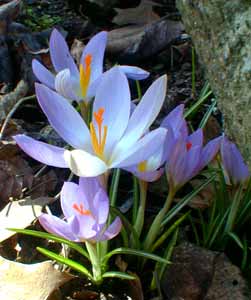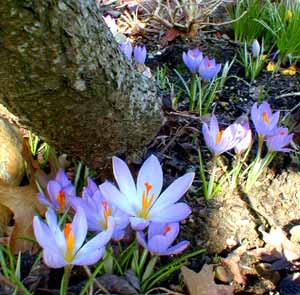 Crocus etruscus 'Zwanenburg'
Crocus etruscus 'Zwanenburg'
"I'll promise my blossoms," the Crocus said,
"When I hear the blackbird sing."
-from "Flower Chorus"
by Ralph Waldo Emerson
1803-1882)
by Ralph Waldo Emerson
1803-1882)
Leafing & budding earlier still, the fully opened flowers occur no later than the second week in February for this botanical crocus.
It's a strain selected for exceptional color by Thomas Hoog, & named Crocus etruscus 'Zwanenburg' after the Zwanenburg Nursery at Haarlem, where many crocus varieties originated.
This drift gleams in pale lilac-blue underneath the chokecherry tree, at a point where the elbow of a fat limb bends down to the ground. Their first year this drift was a tight little area of blooms one foot round, but by its third year it had spread to a two foot area, with a couple misplaced 'Zwanenburgs' bursting out of sod another foot away.
They do naturalize easily, but it seemed so unlikely they could have gone this swiftly from seeds to blooming corms, so I suspected a mole moved some of the original corms up a tunnel before a mole-killing cat got the timorous wee beasty.
 On the other hand, perhaps it really can reproduce just that quickly. Pollinated by bumblebees, moths, & beetles, it will inevitably self-seed, besides producing offsets, increasing in numbers year by year. Its third year, when I cleared away some invading grass, I found two half-sized corms buried in grass upon the surface of the ground, complete with roots & sprouts. So I poked two thumb-deep holes in the 'Zwanenburg' drift & dropped the cormlets therein.
On the other hand, perhaps it really can reproduce just that quickly. Pollinated by bumblebees, moths, & beetles, it will inevitably self-seed, besides producing offsets, increasing in numbers year by year. Its third year, when I cleared away some invading grass, I found two half-sized corms buried in grass upon the surface of the ground, complete with roots & sprouts. So I poked two thumb-deep holes in the 'Zwanenburg' drift & dropped the cormlets therein.Seed capsules appear as the leaves are dying back, & these capsules are large enough to have a decorative value of their own. They are like small mottled green nuts that burst open into three compartments, revealing many lentil-sized seeds already having the appearance of eency bulbs. These produce excellent crocuses of mixed color effects in the lilac range, with occasional stripes on the outer petals.
The pale lilac flowers are in some light nearly blue, paler on the outside, & yellow at the center, justly a recipient of the Award of Garden Merit for beauty, ease of growth, & longstanding garden use.
When the whole assembly of 'Zwanenburg' blooms is getting a bit aged come March, but still with very good appearance on a brightly sunny day, many of the petal-tips are wrinkly, giving the fully open blooms quite an unusual tissue-paper effect.
The species originated in Corsica. It is not terribly cold-hardy but will do well down to USDA zone 6, & does excellently here in zone 8. It requires loamy well-draining soil with lots of sun; it gets direct morning & early afternoon sun in the spot where we planted it.